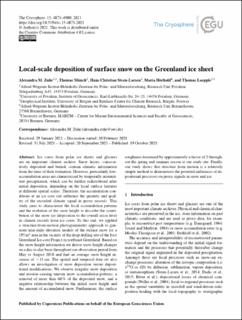| dc.contributor.author | Zuhr, Alexandra M. | |
| dc.contributor.author | Münch, Thomas | |
| dc.contributor.author | Steen-Larsen, Hans Christian | |
| dc.contributor.author | Hörhold, Maria | |
| dc.contributor.author | Laepple, Thomas | |
| dc.date.accessioned | 2022-04-12T08:15:02Z | |
| dc.date.available | 2022-04-12T08:15:02Z | |
| dc.date.created | 2021-12-03T14:54:08Z | |
| dc.date.issued | 2021 | |
| dc.identifier.issn | 1994-0416 | |
| dc.identifier.uri | https://hdl.handle.net/11250/2991011 | |
| dc.description.abstract | Ice cores from polar ice sheets and glaciers are an important climate archive. Snow layers, consecutively deposited and buried, contain climatic information from the time of their formation. However, particularly low-accumulation areas are characterised by temporally intermittent precipitation, which can be further redistributed after initial deposition, depending on the local surface features at different spatial scales. Therefore, the accumulation conditions at an ice core site influence the quantity and quality of the recorded climate signal in proxy records. This study aims to characterise the local accumulation patterns and the evolution of the snow height to describe the contribution of the snow (re-)deposition to the overall noise level in climate records from ice cores. To this end, we applied a structure-from-motion photogrammetry approach to generate near-daily elevation models of the surface snow for a 195 m2 area in the vicinity of the deep drilling site of the East Greenland Ice-core Project in northeast Greenland. Based on the snow height information we derive snow height changes on a day-to-day basis throughout our observation period from May to August 2018 and find an average snow height increase of ∼ 11 cm. The spatial and temporal data set also allows an investigation of snow deposition versus depositional modifications. We observe irregular snow deposition and erosion causing uneven snow accumulation patterns, a removal of more than 60 % of the deposited snow, and a negative relationship between the initial snow height and the amount of accumulated snow. Furthermore, the surface roughness decreased by approximately a factor of 2 throughout the spring and summer season at our study site. Finally, our study shows that structure from motion is a relatively simple method to demonstrate the potential influences of depositional processes on proxy signals in snow and ice. | en_US |
| dc.language.iso | eng | en_US |
| dc.publisher | Copernicus Publications | en_US |
| dc.rights | Navngivelse 4.0 Internasjonal | * |
| dc.rights.uri | http://creativecommons.org/licenses/by/4.0/deed.no | * |
| dc.title | Local-scale deposition of surface snow on the Greenland ice sheet | en_US |
| dc.type | Journal article | en_US |
| dc.type | Peer reviewed | en_US |
| dc.description.version | publishedVersion | en_US |
| dc.rights.holder | Copyright 2021 The Author(s) | en_US |
| cristin.ispublished | true | |
| cristin.fulltext | original | |
| cristin.qualitycode | 2 | |
| dc.identifier.doi | 10.5194/tc-15-4873-2021 | |
| dc.identifier.cristin | 1964495 | |
| dc.source.journal | The Cryosphere | en_US |
| dc.source.pagenumber | 4873-4900 | en_US |
| dc.identifier.citation | The Cryosphere. 2021, 15 (10), 4873-4900. | en_US |
| dc.source.volume | 15 | en_US |
| dc.source.issue | 10 | en_US |

